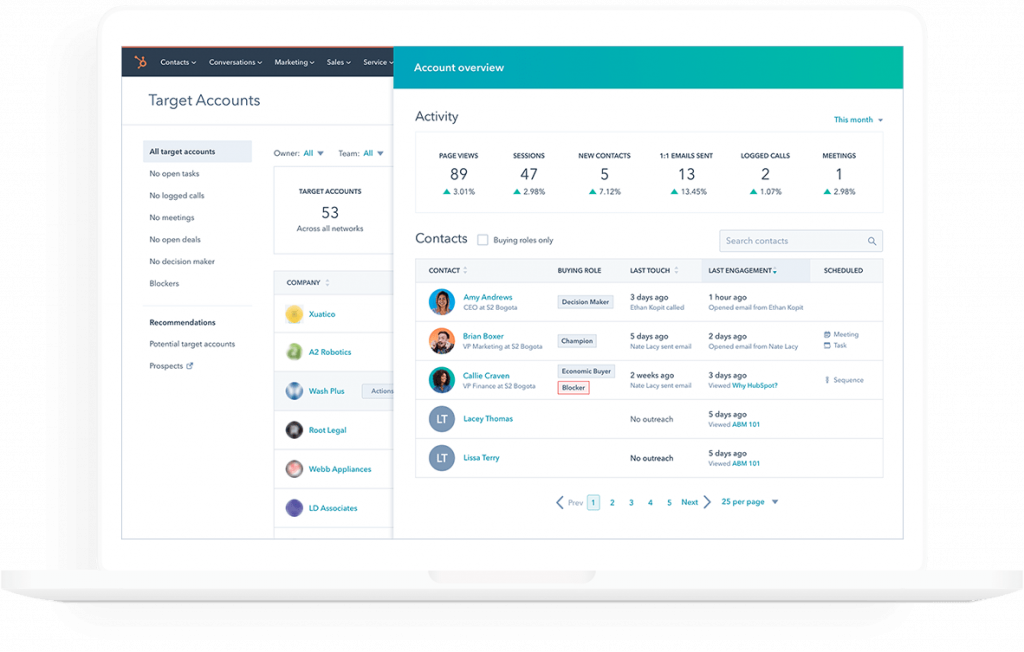In the dynamic landscape of contemporary business, effective communication stands as the cornerstone for success, particularly within sales and marketing teams. The advent of B2B SaaS solutions has brought about a paradigm shift, revolutionizing the way teams collaborate and communicate. This article explores the transformative impact of B2B SaaS solutions on team communication within the realms of sales and marketing.
Bridging the Communication Gap
Among the myriad virtues of B2B SaaS solutions, their remarkable ability to bridge communication gaps across sales and marketing teams takes center stage.
- Centralized Collaboration Hub: Traditional silos crumble as these platforms establish a centralized hub for collaboration, facilitating seamless information sharing and real-time updates for both office and remote work.
- Unified Interface Dynamics: Through a unified interface, team members can effortlessly exchange insights, cultivating a more cohesive and agile working environment.
Communication Tips for Optimal Team Dynamics
Effective team communication is not solely about one thing; it’s also about adopting proactive strategies that enhance collaboration.
Scheduled Check-Ins: Regular check-ins ensure that team members stay connected, fostering a sense of accountability and collaboration.
Clear Communication Protocols: Establishing clear communication protocols helps avoid misunderstandings, ensuring that messages are conveyed with precision and intent.
Enhanced Data Accessibility: In the intricate landscape of sales and marketing, data reigns supreme.
Data-Driven Decision Making: B2B SaaS solutions empower teams by granting unparalleled access to pertinent data and analytics, promoting data-driven decision-making processes.
Universal Alignment: Accessibility not only streamlines decision-making processes but also ensures universal alignment, creating a shared understanding among team members.
Choosing Appropriate Tools: This is crucial in ensuring seamless communication, particularly in an era where remote work is prevalent. Recognizing this need, Krisp has suggested a list of AI meeting assistant tools that help B2B professionals connect with both remote workers and other businesses more efficiently.
Breaking Down Departmental Barriers
Traditionally confined within distinct spheres, sales and marketing teams have historically grappled with inefficiencies and misalignments.
- Synchronized Communication Flow: Through shared dashboards and integrated tools, sales and marketing professionals can collaborate seamlessly, leading to a more synchronized and effective communication flow.
- Cross-Functional Collaboration: B2B SaaS solutions dismantle these barriers, fostering cross-functional collaboration through shared dashboards and integrated tools.
In embracing cross-functional collaboration and synchronized communication flows, sales and marketing teams not only overcome historical challenges but also pave the way for a more agile and united approach to achieving common objectives.
Improved Customer Relationship Management
Beyond internal team dynamics, effective communication plays a crucial role in managing customer relationships. B2B SaaS solutions commonly incorporate Customer Relationship Management (CRM) tools, delivering a comprehensive overview of customer interactions. This integrated strategy ensures that both sales and marketing teams stay well-informed about customer touchpoints, presenting a united front in client engagement.
For an advanced approach, consider Salespanel.io, an innovative B2B SaaS solution. It goes beyond conventional CRM tools by empowering sales and marketing teams to comprehensively understand their visitors, leads, and customers. Through its robust features, Salespanel.io facilitates the capture and analysis of data at every stage of the buyer journey. This involves utilizing data to qualify leads, enabling teams to nurture them throughout the process, thus enhancing the efficiency of the sales funnel.
This platform furnishes a dynamic playground where teams can use real-time data to customize engagement strategies. By incorporating this tool, businesses can not only identify and prioritize high-value leads but also personalize their approach based on individual customer behaviors and preferences.
Leveraging Predictive Analytics
Beyond the transformative impact of B2B SaaS solutions and Salespanel.io, predictive analytics emerges as a powerful tool for sales and marketing teams. By harnessing advanced algorithms and data modeling, predictive analytics empowers organizations to anticipate customer behaviors, enabling more proactive and targeted engagement strategies.
Embracing AI
AI tools have become indispensable assets in the ever-evolving landscape of B2B marketing, offering innovative solutions to streamline processes, enhance decision-making, and elevate customer engagement. In this digital era, where precision and agility are paramount, integrating an AI sales coaching platform or other AI tools that can make your team learn more and be more efficient emerges as a strategic recommendation. These dynamic tools provide personalized insights, real-time feedback, and data-driven strategies, presenting an opportunity to not just meet but exceed the expectations of modern B2B marketing endeavors.
Gamifying Sales Strategies
Injecting an element of gamification into sales strategies brings forth a fresh and engaging dynamic. This innovative approach captivates sales and marketing teams by incorporating game mechanics that transcend traditional methodologies.
- Challenges: Introduce targeted challenges to stimulate problem-solving and creativity among team members.
- Rewards: Incentivize achievements with rewards, fostering a sense of accomplishment and motivation.
- Competitions: Foster healthy competition through friendly contests, promoting teamwork and camaraderie.
Gamification ultimately leads to improved overall performance by boosting motivation, fostering healthy competition, and enhancing collaboration.
Orchestrating Customer-Centric Experiences
In the era of heightened customer expectations, prioritizing customer-centric experiences becomes pivotal for sales and marketing teams. Tailoring not only product offerings but also communication strategies to align with individual customer preferences is paramount.
- Tailored Product Offerings: Customize products to meet specific customer needs and preferences.
- Personalized Communication Strategies: Craft messages that resonate with individual customer profiles, enhancing engagement.
- Enhanced Customer Connections: Building stronger connections with the audience through personalized experiences fosters brand loyalty.
By orchestrating such customer-centric experiences, sales and marketing teams can navigate the complexities of the modern marketplace with a focused and strategic approach.
Securing B2B Transactions with Blockchain Technology
Blockchain technology stands as a transformative force in B2B transactions, offering a secure and transparent framework. Its decentralized architecture distributes transaction records across a network of computers, establishing resilience against unauthorized alterations. This foundational shift ensures the integrity of transactions, marking a significant leap forward in the security paradigm for B2B dealings.
Decentralized Assurance
At the heart of blockchain’s impact is its decentralized nature, a key factor fortifying the security of B2B transactions. By dispersing transaction records across a multitude of nodes, the system becomes resistant to tampering and fraud. This decentralized assurance provides businesses with a robust defense against malicious activities, instilling confidence in the integrity of their transactions. The distributed architecture ensures that no single point of failure exists, creating a resilient ecosystem where the security of B2B transactions is safeguarded through collaboration among multiple participants.
Fraud Mitigation
The application of blockchain in B2B transactions is a potent weapon against fraud. The technology’s inherent security features, coupled with its transparent ledger, create a formidable barrier to fraudulent activities. Businesses can rely on the immutability of blockchain ledgers to authenticate the validity of transactions, significantly mitigating the risk of financial malfeasance. Blockchain’s cryptographic principles and consensus mechanisms work cohesively to validate and secure transactions, making it a formidable ally in the ongoing battle against evolving forms of fraudulent activities within the B2B landscape.
Immutable Ledgers and Trust
Blockchain’s immutable ledgers play a pivotal role in fostering trust between B2B entities. The unalterable nature of recorded transactions ensures that both parties can independently verify the authenticity of the exchanged data. This transparency establishes a foundation of trust, vital in the intricate web of B2B interactions where reliability and accountability are paramount. The immutability of blockchain not only enhances the credibility of recorded transactions but also serves as an indisputable source of truth, promoting a culture of trust that underpins the entire B2B transactional ecosystem.
Embracing Innovation
As the B2B sector embraces blockchain technology, the horizon is marked by the promise of increased operational efficiency, reduced costs, and fortified trust in transactions. The innovative potential of blockchain transcends traditional transaction methods, offering a compelling reality where businesses navigate a secure, transparent, and trust-driven landscape. This embrace of innovation extends beyond mere technological adoption; it signifies a paradigm shift in how B2B transactions are conducted, fostering a future where blockchain becomes synonymous with reliability, security, and the next frontier of transactional evolution.
Revolutionizing B2B Presentations with Augmented Reality
Augmented Reality (AR) is at the forefront of revolutionizing B2B presentations, offering an innovative approach to engagement. This emerging technology introduces a new era where static presentations transform into dynamic, interactive experiences. Businesses are leveraging AR to transcend the limitations of traditional methods, unlocking a realm of possibilities in sales presentations.
Visual Engagement Beyond Tradition
In the realm of sales, AR serves as a catalyst for visual engagement that transcends traditional presentation methods. This transformative technology enables sales professionals to create visually compelling presentations that not only capture but fully immerse clients’ attention. By seamlessly incorporating AR elements, presentations evolve into immersive experiences, providing clients with a more profound understanding of products and services. This dynamic visual engagement becomes a powerful tool, allowing businesses to showcase their offerings in ways that resonate more deeply with clients, forging a connection that extends beyond the limitations of conventional presentations.
Real-World Product Showcases with AR
The true power of AR in B2B presentations lies in its remarkable ability to showcase products within the contextual realm of the client’s physical environment. Sales professionals leverage AR to seamlessly place virtual representations of products in real-world scenarios, offering clients an unparalleled and dynamic presentation approach. This method allows clients to visualize products authentically, fostering a more profound connection and understanding of how these offerings seamlessly integrate into their specific operational landscape. AR’s capacity to create authentic real-world simulations marks a revolutionary shift in how businesses present their products, creating a more resonant and memorable impact.
Expediting Decision-Making Processes
AR not only enhances the impact of presentations; it becomes a catalyst for expediting decision-making processes within B2B interactions. The interactive nature of AR empowers clients to actively engage with virtual models, facilitating quicker comprehension and more decisive decision-making. By providing a hands-on experience, AR streamlines the decision phase of B2B transactions, offering a more efficient and informed decision-making process. This acceleration in decision-making not only saves time but also positions AR as a pivotal tool in enhancing the overall efficiency and effectiveness of B2B interactions.
Dynamic Encounters Through Interactivity
The transformative potential of AR extends beyond traditional presentations, turning B2B interactions into dynamic encounters marked by heightened interactivity. AR’s interactive features establish a two-way communication channel, allowing clients to actively participate in the presentation experience. This level of interactivity fosters a deeper engagement and understanding between businesses and their clients, elevating the overall impact of B2B presentations. As clients actively participate in the presentation, the communication becomes more collaborative, creating a shared experience that transcends the traditional boundaries of one-way presentations.
Final Thoughts
In the evolving landscape of business, B2B SaaS solutions redefine team dynamics for sales and marketing. From bridging gaps and breaking barriers to embracing AI, the journey unfolds through proactive strategies, customer-centric approaches, and gamified sales tactics. The integration of AI tools, notably sales coaching platforms, emerges as a key strategy to exceed modern B2B expectations. The exploration culminates in the infusion of gamification, injecting dynamism. As businesses pivot towards customer-centric experiences, tailoring strategies to individual preferences becomes the compass for navigating the modern marketplace. In essence, B2B SaaS solutions propel teams into an era of innovation, efficiency, and heightened engagement.




